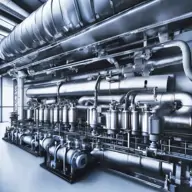What is a Air Distribution Systems and its Functions

Language
English
285 Views
Share
Coming in March, 2025
-
-
This course format is where trainer will explain you the subject via online live session. Date and time are not decided yet but it will be planned within next 2 weeks after you enroll & pay for this course. Get in touch with our team if any clarification is required.
₹ 499
online

₹ 499
Why do you enroll
Key topics covered
Course details
Course tags
Why do you enroll
Mastering Air Distribution Systems and their functions can significantly enhance your career prospects in the HVAC industry. With this knowledge, you'll be poised for advancement to roles like HVAC System Designer, Air Distribution Specialist, or Building Services Manager. Your expertise will enable you to optimize system performance, improve indoor air quality, and increase energy efficiency. You'll be competitive for senior positions like Senior HVAC Engineer, Facilities Director, or Building Automation Specialist, and be well-positioned to pursue certifications like LEED AP or ASHRAE certification. Unlock new opportunities and take your HVAC career to the next level with this critical knowledge.
Show more
Key topics covered
1.Introduction to Air Distribution
2.Airflow Principles
3.Comfort and Air Distribution
4.Indoor Air Quality(IAQ)
5.Energy Efficiency
6.System Performance
7.Duct Design
8..Troubleshooting Airflow Issues
9. Advanced Air Distribution Technologies
10.Maintenance and Optimization
11. Explanation on Key Topics duct accessories like, supply ducts, return ducts, registers/grilles, diffusers, dampers, transitions, elbows, and plenums. And their Functions in ductwork.
12. Discussion on airflow requirements, system capacity, velocity limits, and pressure drop. Explain duct design considerations, including layout, routing, insulation, and sealing etc.
Show more
Course Details
This introductory course explores the fundamentals of air Distribution Systems, a critical component of Heating, Ventilation, and Air Conditioning (HVAC) infrastructure.
Module 1.
Importance of Air Distribution: Discuss the significance of proper air distribution in HVAC systems, emphasizing its impact on comfort, indoor air quality, energy efficiency, and system performance.
Module 2.
Ductwork Components: Provide an overview of the different components of ductwork, including supply ducts, return ducts, registers/grilles, diffusers, dampers, transitions, elbows, and plenums. Explain the purpose and function of each component.
Module 3.
Duct Sizing: Discuss the factors influencing duct sizing

Show more
Course tags
Industry domains :
Engineering Disciplines :
FAQs on What is a Air Distribution Systems and its Functions
Having specific question ? Ask now
Trainer’s Feedback
5 course rating
1 ratings
MR
Manmohan Reddy Gayam
2 months ago
Nice explanation with PPT's...
Certificate of Mastery

Receive well recognised certificate that you can showcase on
Featured courses
Hazard Identification and Risk Assessmen...

How to prevent corrosion in the oil and ...

Application and use of "Green Hydrogen"

Career in EPC projects for Freshers

Career in EPC Cost Estimation

Learn MATLAB Programming

More Technical Courses From Yogesh Kulkarni
Troubleshooting HVAC Systems: Online Tra...

Energy Efficiency in HVAC: Strategies an...

Mastering HVAC Control Systems: A Compre...

Balancing Airflow in HVAC Systems: A Pat...

What is a Air Distribution Systems and i...

Important Equipments of Chilled water sy...

Different Types of HVAC Systems

Basic Fundamentals of HVAC

Similar Content Learn:
Basic of CMS IntelliCAD and GD&T

Buffer Tank - Basic, Concept, Design, Ca...

Business Excellence through Quality, QMS...

Renewable Energy, Energy Storage Systems...

Instrumentation and control in Real worl...

Become HVAC Professional: Comprehensive ...

Similar Content Mentor:
All About Interviews

Presentation Skills _ Part 2

Similar Content Seminar:
The Petrochemical and Refining Congress:...

7th International Oil & Gas Chemistry, C...

Similar Content Blogs:
What is Piping Engineering?

Types of Piping Valves for Oil and Gas I...

PRC Europe 2025: Where Industry Leaders ...

Technical Basis for Impact Test Exemptio...

Aerodynamic physics of the Delta Wing

Seal of Hydraulic cylinder.

PRC Europe 2025: Italian Partners at the...

Similar Content Community:
Firefighting Design By Naga

Engineer's Corner

Cathodic protection

Corrosion

Cae engineers

Similar Profile:

Vijay Sachdev
Consultant - Project & Pr...

Debojyoti sen
MD & CEO, SAURYAJYOTI REN...

Sabari Kuppuraj
Engineer

Atul Kabre
Independent Consultant

Sawrabh Raj
Sr Instrumentation Design...

BGS Group
The organiser of closed-d...





































